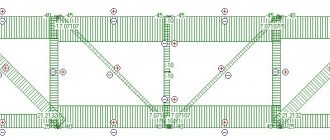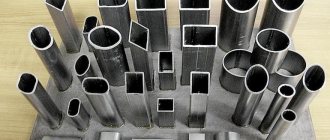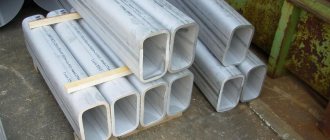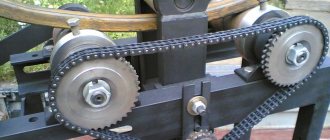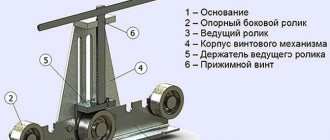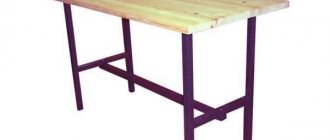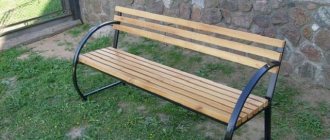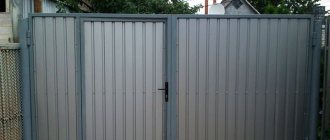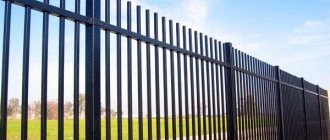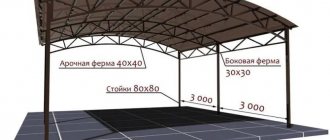Profitable, beautiful and durable
In private construction, the most popular use of a 25x25 mm pipe profile in the installation of fences. Moreover, we are talking about both a supporting structure and a decorative one with forged decor. This type of rolled metal is produced with different sections, so it is possible to vary the fencing both in terms of rigidity and possible loads, as well as in appearance and cost.
Inexpensive and attractive fencing can be made from pipe at a fairly low cost. The simplest version is a fence made of a profile pipe with forging elements, which involves welding the supporting structure with pillars made of a 25x25 mm pipe and connecting metal slats. Then a vertical pipe with a square cross-section of up to 10-15 mm is welded at a distance of 10-20 cm.
The only drawback of this type of rolled metal for the manufacture of fences and gates is its key feature - it is a hollow structure. The result is a fence that is lighter and less expensive than products made from squares, but it has the disadvantage of corrosion that occurs inside the pipe.
In this case, this issue is resolved through decorative finishing. For example, using standard decor such as peaks, which are welded onto the end of the pipe, and then the entire product is covered with a protective decorative coating.
Pipe bender for furniture frames made of round pipes
In furniture production, in the manufacture of frames for chairs, beds, medical carts, strollers, gurneys and other medical furniture, round pipes are often used.
In this case, 3-axis machines are needed, which, in addition to the bending angle and linear extension to the bending start point, are also programmed according to the angle of rotation of the pipe in space.
Pipe benders for furniture pipes, produced by BMK:
- Mandrel, 3-axis programmable manual pipe bender CM-30/3 PARTNER;
- Semi-automatic mandrel 3-axis programmable pipe benders CE-30/3 PARTNER and CE-51 MASTER;
- Mandrel, 3-axis pipe bending machines CE-30 PARTNER.3X and CE-51 MASTER.3X;
The presence of a mandrel ensures excellent bending quality. In addition, the mandrel allows the use of thin-walled pipes, the rigidity of which is sufficient for long-term use of furniture, and the price of the pipes is much lower. Considering that pipes are sold in kilograms, naturally there will be more thin-walled pipes per meter, and therefore more furniture frames, chairs and other furniture can be produced.
You can calculate how much one linear meter of pipe will weigh using the formulas:
For steel pipes manufactured according to GOST8734-75 and GOST8732-78
A=0.02466148*S*(Dн-S), gram
For stainless steel pipes manufactured according to GOST9941-81 and GOST9940-81
A=1.08*S / (0.08+S/D), gram
where A is the weight of one linear meter of pipe, gramDн is the outer diameter of the pipe, mmS is the thickness of the pipe wall, mm0.02466148 / 1.08 / 0.08 - conversion factors
Accordingly, knowing the length of the blanks, you can easily calculate the required number of pipes and compare their weight and cost, and then select pipes of the optimal size.
Pipe bending machines of the Partner series and Master series work perfectly with thin-walled pipes made of steel, aluminum, copper, and titanium.
Features of manufacturing round chair seats using pipe benders.
Often the seats of chairs and bar counters are made from rings, which are easiest to make from a straight pipe, curled into a spiral with a turn adjacent to the turn. Then the spiral is cut into rings. which are welded by any type of welding. This method of manufacturing rings has become widespread when using pipe benders (profile benders) of 3-roller (roller) bending models 3RE-60 (BMK-55), 3RE-80 (BMK-55U), 3RE-30 Junior, 3RM-30 Start. These machines will allow you to obtain a ring or sector of any radius on any pipe within the technical characteristics of pipe bending machines.
Thus, on JUNIOR and START pipe bending machines the minimum bending radius is 150 mm, and on pipe benders 3RE-60 (BMK-55) and 3RE-80 (BMK-55U) - 300 mm. Note that on roller machines with three drive rollers, repeatability and productivity are much greater. However, only on pipe benders 3RE-60 (BMK-55) and 3RE-80 (BMK-55U), with large bend radii, the need for the operation of pressing the pipe and profile can be eliminated from the work cycle by synchronizing the rotation speed of the bending rollers. This operation is performed only once at the beginning of the work shift, due to the fact that on all 3 bending rollers the angular speeds of rotation of the rollers and the linear feed speeds of the bent pipe (profile) are consistent.
Having mandrel and roller pipe benders produced by Baltic Machine-Building in your furniture production, you will be able to implement any plans for the production of frame furniture.
Square pipe for fencing frame
A pipe with a square cross-section is used to make the frame of wickets and gates; the middle part of the plane is filled by welding the pipe and decor; to cover the canvas, sheet metal and transparent plastic are used. Forged decor is made from sheet metal by stamping and mechanical rolling to create texture, pipe and square. A pipe is an easier material to manufacture using the mechanical molding method, when a metal blank is given a certain shape by bending it along a rigid tooling.
To make decorative items from pipes, a pipe bender is used, as well as a specialized tool for making curls. This equipment usually allows you to bend entire rolled metal with a cross-section suitable for the size of the snail.
Using a pipe compared to a square is more advantageous for several reasons:
- lighter weight and lower costs for purchasing material;
- structural strength;
- flexibility of the pipe in operation, which reduces labor intensity;
Collapsible forged decor is sold cheaper, but is not inferior in appearance and quality to a traditional square with a small cross-section. When making your own gate from a profile pipe with forging elements, a pipe profile of two sections (for construction and finishing) and optional forging is sufficient. If you have a welding machine, making a wicket, gate or fence with your own hands is not particularly difficult. You can look at the photo for options for implementing different artistic ideas with different costs.
Design of a homemade rolling machine
To roll a profile pipe, you need to make a simple device that will implement the following ideas:
- the pipe moves between guide bearings installed with a small gap (0.2...0.4 mm);
- Profiling rollers will press on it from above and below. When pushing the workpiece between them, the upper and lower edges will collapse. The side edges will not change.
Rolling machine for profiling pipes 20·20 mm: 1 – stand; 2 – body-cover; 3 – rolling roller; 4 – bearing
Between the upper and lower housing-covers 2, bearings 4 are located on special axes. The distance is chosen so that with a small gap the profile pipe can pass between them.
Rolling is carried out by two rollers 3 mounted on special stands 1. They are welded to the housings so that the rollers crush the pipe by 2.0...2.5 mm on each side.
The body-cover is made of a 6 mm thick plate
The roller must be made of high-strength structural steel. 65G spring steel can be used
There is no need to use expensive material to make the stand. Regular quality steel will do
The design provides for the use of a handle to rotate the roller. Similar handles are used on washing machines produced in the eighties and nineties of the last century. They can be found at metal depots and scrap metal collection sites.
Buying or making forged decor
Decorative elements of cold forging from profile pipes for fences, gates and gates can be made independently or purchased from a large supplier. It will usually cost less to buy if you want to make one set for your home garden.
Read also: How to work with a hydraulic level alone
For these purposes, you do not need to buy equipment for cold forming, but only a welding machine and an angle grinder. All decorative elements are available for sale, so any fence can be made not only based on budget requirements, but also according to your own or selected sketch.
The use of forged semi-finished products significantly reduces the cost of products, as well as the complexity of implementation. To make such functional forged decor for a household plot, you only need a tool, which, as a rule, is already on the farm. How you can assemble a fence with your own hands from ready-made elements or make it entirely from a profile, watch the video.
Today, small home metal processing workshops have become widespread. This is both a hobby and additional income for the family budget. Do-it-yourself cold forging is more common. This technology does not require large expenses at the initial stage, and handmade products are highly valued.
What technologies and techniques are used in this method of metalworking, and what do you need to know about production operations? More on this later in our material.
Useful tips for “pioneers”
For those who are encountering flexible profiles for the first time, it is recommended to take into account some features of the processing technology of this type of pipe. For example, experienced craftsmen never sacrifice the quality of the bend to save time.
It is wiser to do a few gentle presses with the adjusting screw and a few passes on the rollers rather than doing everything at once. This approach completely eliminates deformation of the profile pipe and significantly reduces the load on the drives (or on the master’s muscles).
A made template for the required bend radius of the pipe. Similar templates are also made for profile pipes
It is recommended to work with rollers of a configuration that matches the pipe profile. So, if there is a correspondence between the size of the roller width and the cross-sectional size of the profile, the bend will be accurate and neat. In addition, the master will not have to periodically correct the pipe, which moves from the center of the support roller to its outer boundary.
Before starting the bending operation of a profile pipe, it is advisable to make a template according to a given bend radius. If it is impossible to make a template for some reason, you can limit yourself to calculating the distance obtained between two control points after bending the pipe. Knowing the calculated figures, the workpiece can be bent with a pipe bender without periodic control measurements, thus reducing work time.
Cold metal working concept
The cold process mainly processes rolled metal in the form of rods, squares, circles, strips or sheets.
Special devices and tools are used for production, and they are often highly specialized and not suitable for work in other areas.
Heating blanks to forging temperature is not provided for by technology, which uses one of the main properties of metal - plasticity. Heating is only possible partially in places where some products are bent (for example, when the metal of the starting material is too thick).
Cold forging of metal is used for the manufacture of grilles, fences, gates, wickets (and individual elements of their decorations), furniture frames and various decorative details.
Moreover, during the production of these products, the metal can be pressed and bent, which makes the product even stronger than with hot forging, since the properties of the metal do not change, and the crystal lattice, on the contrary, is strengthened due to compression.
Cold forging at home is quite simple, but at the same time, it is a complex technological process that requires experience. What do you need to know about such metalworking, and also what is required to manufacture products without heating the materials?
Types of rollers for bending profile pipes
A rolling device for deforming corrugated pipes is briefly called a profile bender or, by analogy with its working part, rollers.
The design of the working body of profile bending machines is the same:
- body or frame - a massive base of the structure,
- three cylinder shafts - two supporting and one pressing or driving,
- clamps - nozzles that fix the position of pipes of different sizes on shafts,
- device that regulates the position of the drive shaft,
- a control mechanism responsible for the movement of the shafts.
The classification of pipe benders for corrugated pipes implies division according to the method of controlling the device.
There are several types of rollers: hydraulic, electric, manual or mechanical.
Hydraulic profile benders
They are equipped with a hydraulic drive, thanks to which they work with high productivity. The support shafts in the hydraulic machine are connected to the drive and not only guide the pipe, but advance it at the required speed. Thus, the device operates without human assistance, reducing the operator’s task to pressing buttons and visually monitoring the process. Such machines are the most powerful, accurate and highly productive, but massive and expensive. The use of hydraulic rollers is advisable only in an industrial enterprise.
Electric rollers
The support and pressure shafts are connected by a chain and rotate at the same speed, ensuring the feeding and transportation of workpieces. Such a device is cheaper and lighter than a hydraulic one, and is suitable for small-scale production of rolled pipes. However, electric rollers have significant dimensions and weight, and in order to work they need to be connected to an electrical network, so their scope of application is small enterprises and private workshops. It is not practical to buy or make an electric pipe bender for the construction of one or two outbuildings.
Mechanical roll forming machine
Such a device is compact, mobile, inexpensive and can even be made independently. In this case, the device is controlled manually, which requires serious labor costs when bending pipes with a large cross-section. The productivity of hand rollers is low, so such devices are used only for piece production of bent profile pipes.
Homemade devices
The purchase of even a manual profile bender is not always justified: if several arcs are needed to erect a canopy, gazebo or greenhouse, the purchase of the device will negate all the savings from bending the pipes yourself, since in the end it turns out that it would have been cheaper to buy ready-made products.
If you have experience working with welding equipment, you can build a manual rolling machine yourself. At the same time, the finished rollers will not be inferior in efficiency to factory models, and the device, if desired, can be modified by equipping it with an electric motor to increase productivity.
DIY cold forging
The entire workflow for creating products using cold forging can be divided into several stages.
- Drawing or diagram of the finished product.
- Selection of materials.
- Metal processing and parts manufacturing.
- Assembly and finishing.
Drawing
In the drawings of the future product, all dimensions of parts, angles of individual elements and landing points are calculated and marked.
It can be made either manually or using modern computer programs such as AutoCAD.
The main thing is to draw the diagram on an approximate scale so that you can easily carry out calculations without problems. The purpose of such a drawing is to accurately determine the names and quantities of required parts, count materials, and correct final assembly of the entire product.
Materials
Various types of rolled metal are processed in cold forging.
Almost all elements are produced from rods or squares: finials, crow's feet, curls, spirals, monograms and others.
But workpieces such as sheet metal, steel strip and profile pipe are also cold processed. Spirals, leaves, or the same curls with volutes are made from them.
The dimensions of processed rolled products depend on the power of the equipment. For example, manual machines are not capable of bending a rod thicker than 14 millimeters.
Read also: Is it possible to repair an LED light bulb?
In some cases, non-ferrous metals can also be processed using cold forging: copper, aluminum and others.
When the drawing is ready, you can easily calculate how much of one or another type of rental is needed to create a thing.
Material processing
At this stage, all the individual parts of the product are created and prepared for assembly. On the equipment, if necessary, the production of the following forged elements is carried out.
- Tabs, peaks, finials - for finishing the ends of trellises or other linear parts.
- Curls - these include their own subtypes: volute (ends bent in one direction), chervonka (spirals in different directions), commas (simply a curved end of a rod).
- Rings.
- Baskets are two rods twisted in a spiral and connected at the ends.
- Torsion bars are rods or strips twisted around their axis.
All these elements are produced on special equipment capable of bending metal blanks without heating to forging temperature. In workshops for the production of cold forging products with their own hands, they use the “golden six” workbenches: bender, snail, flashlight, twister, volumetric and wave.
Metal processing is based on three main technological
As in hot forging, drawing involves rolling out the metal in order to reduce its cross-section. In cold forging, this technology is used to produce peak or houndstooth elements.
To make a cold drawing, a rolling machine is required, which flattens the end of the workpiece. Using stamps, the relief is immediately applied. Peaks are produced on presses, giving the workpieces the desired configuration.
Bending is practically the main process on which cold forging is built. The machines listed above (except for the twister and flashlight) operate on the same technological principle. The most commonly used is a snail, which forms a large list of different kinds of curls (monograms, volutes, spirals and others).
Torsion is based on the properties of metal - plasticity and the ability to maintain a given shape. During such processing, the workpiece is twisted under force around its axis. Usually the procedure is done on a twister. However, items such as baskets are produced using a flashlight. It is capable of twisting several workpieces, thereby forming a three-dimensional element.
Usually all processing is carried out cold, however, sometimes it is necessary to heat certain points on the workpiece. This is done when bending or twisting thick parts or when defective elements need to be corrected. Heating can be carried out in a forge or with a gas cutter to a temperature of 200-300 degrees, which is significantly lower than the forging temperature.
Also, standard methods are used in cold metal processing: cutting, chopping, grinding and others. For this purpose, grinders, cutting wheels, grinders, guillotines, chisels and others are used.
Assembly and finishing
These two stages complete the process of manufacturing products using cold forging.
Assembling parts into a single combination is carried out in several ways:
The easiest and fastest method to assemble a product is electric or gas welding (the latter is used less frequently).
However, some parts are fastened with clamps and rivets, if this is provided for by the style.
Previously, forge welding was used, which today has lost its relevance due to the labor-intensive process.
Final finishing includes grinding, cleaning metal surfaces, as well as applying a decorative coating (paint or any other). After which the work is considered complete and the finished product is installed as needed.
What can you add to the material in this article from personal experience? Share it in discussions and leave your comments.
Home page » machines for cold forging of profile pipes
Read also: How to clean aluminum from oxidation
On this page you will find information on the topic “cold forging machines for profile pipes”, as well as links to other pages of our website that are related to this topic. Read the detailed information below, to find out more, please follow the links that interest you; at the end of the page there is a list of pages with this label.
Machine "BLACKSMITH UNV-3-220".
In various metal structures, profile pipes - rolled metal, the blanks of which have a cross-section different from round (square, rectangular, oval). to increase the number of products manufactured using profile pipes. This section is dedicated to this list of equipment.
In addition, the following equipment is in use in cold forging technology for bending workpieces of different sections:
- universal machines;
- special machines (manual, hydraulic, electromechanical), among which devices (snails) for making workpieces in the form of curls and spirals, as well as benders for producing arc-shaped elements are in particular demand; with the help of conductors of different configurations it is possible to obtain elements of different shapes;
- tools.
Features of metal furniture
Using metal structures in the garden is associated with some difficulties, but there are also advantages.
Beautiful forged metal chair and bench
The main points that are important to pay attention to:
First of all, potential users are attracted by the strength characteristics of the metal. If we are not talking about cheap products, then they last a long time and cannot be broken even by heavy loads.
Advice! The service life of a product largely depends on the quality of its care. Metal requires periodic renewal of protective coatings, as it begins to corrode in atmospheric humidity.
Set of table and chairs
- Metal garden furniture looks beautiful and elegant. It goes well with living plants, especially if forged elements are added to the design.
- Homemade amateur models, like those made from any other material, are distinguished by their angularity and discreetness. They cannot be called elegant, but by using ready-made decorative parts, you can achieve a good result.
- The material can be dyed many times, due to this you can maintain its attractiveness for a long time. Some metals do not require any treatment, since they practically do not oxidize - aluminum or stainless steel.
- Metal is often used as a durable frame, and seats and backrests are made from other materials - wood, plastic, WPC, etc. This allows us to combat the obvious disadvantage of designs.
Country metal bench with soft seat
Any metal has high thermal conductivity. Because of this, it quickly cools down or, on the contrary, gets very hot in the sun, which makes tactile contact with it unpleasant, but in the summer you really want to sunbathe, so you won’t see such furniture near the pools.
Simple and stylish - frame made of rectangular profiled pipe and soft stuffed pillows
- Metal is easy to care for, apart from annual painting. It is wiped with damp cloths at some intervals.
- Protected products easily withstand moisture and do not suffer from ultraviolet radiation. There is no biological threat to metal - mold, bugs, rodents.
Metal garden furniture set
Another drawback is the heavy weight, especially of structures made of cast iron. Only physically strong and healthy people can move furniture. Therefore, it is installed in place once and is not moved anywhere else.
Metal products are combined with many landscaping styles. They are desirable for classics and modern. You cannot do without such attributes in modern trends, for example, loft or hi-tech. The external shape and appearance of the furniture will be strikingly different.
Characteristics
Without heating, using the cold plastic deformation method, it is recommended to bend profile pipes with a square side of no more than 80 mm .
Manual bending machine BLACKSMITH M3-G. Photo 220Volt
Pipes with a square side size of up to 30 mm are bent on manual machines. To increase the productivity of machines, group bending of profile pipes stacked next to each other is used. The width of the row depends on the design of the machine and its power.
Selection of designs and materials
Materials are selected taking into account their performance. For the base, take beams that are not curved; rust on them can occupy an area of no more than 10%. So that work does not have to be interrupted to search for missing materials, prepare the elements in advance:
- bearing units with pressed rolling rollers;
- channel, it should be taken No. 100 or 80;
- monolithic steel shafts with a diameter of at least 80 mm;
- metal rod with a diameter of 12 mm;
- steel strip with a thickness of 5 mm or more;
- bicycle chain or timing chain from a Zhiguli gear;
- engraving and simple nuts, washers, M20 bolts, the last length is 60 mm.
Brands, brands, manufacturers
From the rich variety of foreign and Russian manufacturers, the following companies can be distinguished, based on customer reviews:
- Manual pipe benders:"Stalex" (the main production is in Europe), "Smart&sol >
- Electromechanical pipe benders: “Blacksmith” (a popular Chinese manufacturer of equipment for cold forging in Russia).
Hydraulic pipe bender Stalex HB-60 Premium. Photo VseInstruments.ru
With your own hands
Pipe benders of any design can be made by hand. As with the vast majority of equipment for cold forging, the design of machines for bending profile pipes allows the use of materials and components that can be found in private households.
It is also possible to assemble other types of cold forging machines yourself. Homemade bent, snail, flashlight and globe are most used in cold forging projects at home. The presence of these devices ensures the production of elements of various configurations.

